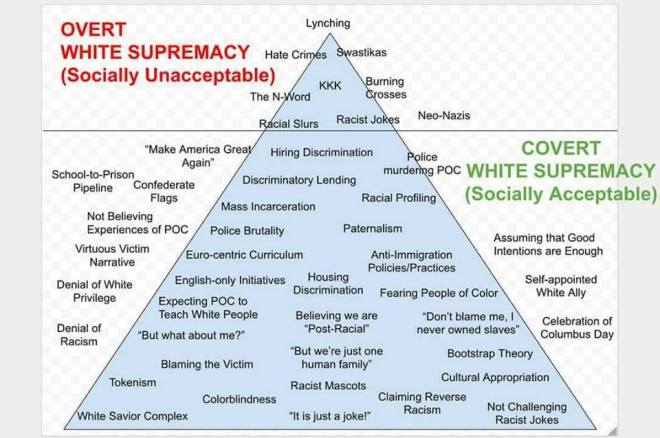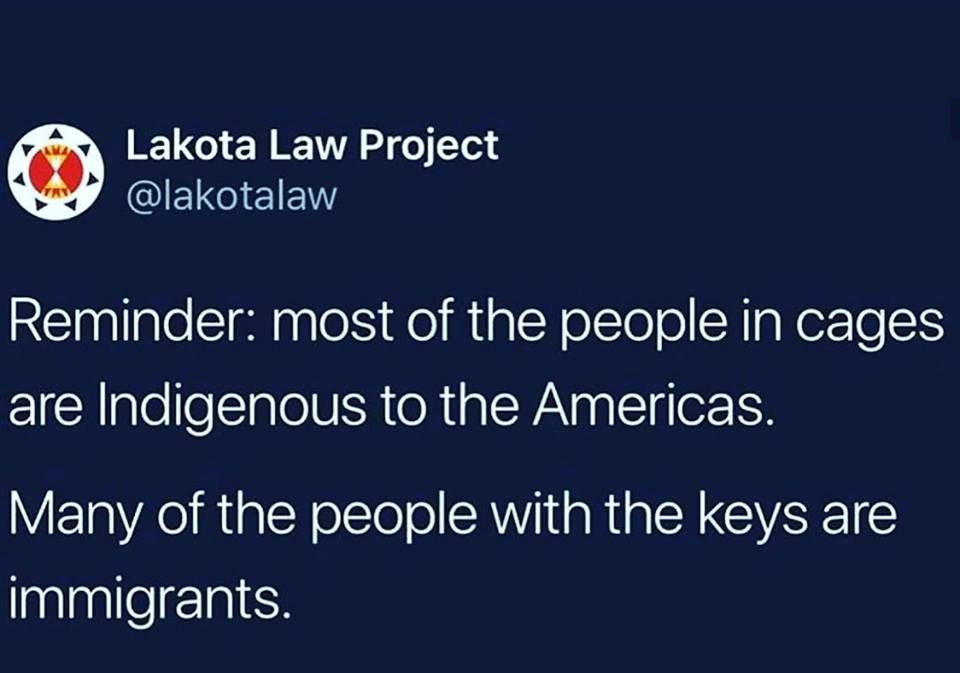Written by Grace Deason, La Crosse Area SURJ Member
“This is heartbreaking. So much damage is being done right now.”
“There is something wrong with these border patrol agents. How could they do this to children?”
“When is someone going to do something? I wonder when it will end?”
Maybe you read these sentences somewhere: a Facebook post by a friend, a comment on an article. Maybe you wrote these sentences. Maybe the thoughts expressed here crossed your mind as you purchased food for your family, as you tucked your children into bed last night.
These sentences raise some troubling but revealing questions: Who is doing the irrevocable damage to children and families at the U.S. border? Who has the power to stop it? The answer, of course, is US—we did this. We are doing it. White Americans, in particular, need to come to terms with the powerlessness we feel and to recognize that powerlessness for the lie that it is.
White Supremacy Culture
Culture is the knowledge, experience, beliefs, and values shared among a group of people. Certain behaviors, attitudes, and customs come to constitute a way of life and are transmitted seamlessly from one generation to another. All of this happens without our consent, outside our control, even without our conscious knowledge—culture is the water and we are the fish, immersed in its invisible but all-encompassing presence.
White Americans have a culture. This fact is obvious to others, yet many within our group remain largely oblivious. So, what are some characteristics of the water that white people are swimming in?
Because of the power that white people have held throughout history in the U.S., white culture defines what is “normal” in the U.S., and judges deviations from that standard as “less than.” White culture justifies the exploitation, oppression, and abuse of those who are “not white” through this ideology of superiority—revealing that white culture is, in fact, a culture of white supremacy.
One feature of white supremacy culture is defensiveness. In white culture, structures are set up and energy is directed toward protecting power as it exists, rather than sharing power and accepting the best of what each person has to offer. As a result, criticism of those in power is seen as offensive and rude. New and challenging ideas are silenced, and this defensiveness reinforces an oppressive structure.
White supremacy culture is also characterized by individualism. White people believe they are responsible for solving problems alone, and feel uncomfortable working as a team. Instead, we are socialized to compete with one another for personal recognition. This can leads us to feel powerless in the face of problems that are too big for any one person to handle. Individualism also obscures white people’s understanding of their membership in a racial group. As a result, we may refuse to take responsibility for the actions of our group, even as we endorse the group’s norms and values.
These are only a few of the characteristics of white supremacy culture. Others can be found here: https://www.showingupforracialjustice.org/white-supremacy-culture-characteristics.html.
Maybe you’re thinking, some of these characteristics don’t sound uniquely white. As the primary power-holders in the U.S., white people’s reality influences everyone—racially diverse folks included. Racially diverse people are socialized to compare themselves to the white-imposed standard, to fit in, to attempt to meet it in order to receive respect and resources. White supremacy culture also impacts racially diverse people through active harm—be it economic, physical, or psychological.
How White Supremacy Shows Up in U.S. Detention Camps
So, what does any of this have to do with the inhumane treatment of immigrants and refugees in U.S. custody? As unsettling as it can be to admit that a belief in white superiority—that is, racism—is fundamental to who we are, there is ample evidence to show that this is the case.
Studies show that white people are less troubled by the pain and suffering of people of color than that of white people. White children as young as seven believe that Black children are less susceptible to pain than white children (https://news.virginia.edu/content/study-racial-bias-pain-perception-appears-among-children-young-7). In a clear extension of this basic finding, a study of emergency room personnel found that Black and Hispanic children were less likely to receive pain medication than white children (https://abcnews.go.com/Health/Wellness/black-children-pain-meds-er/story?id=16231146). It’s not hard to conclude that brown-skinned children at the border are being treated more harshly than white children would be, because of their ethnicity and skin color.
White supremacy is also implicated in people’s support for the immigrant detention system as a whole. In one study, white Americans who were informed about Black people’s overrepresentation in the U.S. criminal justice system were more likely to support punitive policies like California’s Three Strikes Law (https://news.stanford.edu/news/2014/august/prison-black-laws-080614.html). Another study found that white people become more supportive of the death penalty in the U.S. after learning that it discriminates against Blacks (https://www.jstor.org/stable/4620112?seq=1#page_scan_tab_contents). Given these findings, it is hardly a stretch of the imagination to conclude that, were the detainees along our southern border white, Americans would be renouncing the current immigration policies all the more strongly.
“But it Wasn’t Me!”
A defensive reaction is built into the system of white supremacy. Because we are socialized to see ourselves as individuals disconnected from the system we built, we feel neither responsible nor capable to make change. However, white people think and act in small ways every day that prop up the system of white supremacy—we cause and allow these harms.
The white supremacy pyramid illustrates how common, seemingly innocuous beliefs like “colorblindness” and our denial of responsibility enable overt racist acts like hate crimes and lynching. We may not always be in a position to stop a hate crime with our bare hands, but we can work on dismantling the lower levels of this pyramid. The way that we understand reality influences how we think about individual behaviors and policies. The way we think about an issue influences how we talk about it. The way we talk influences the beliefs and actions of others around us. And so on.

How have you come to understand immigration? Did you consciously choose what to think, or are unconscious tendencies driving your views? For example, a common temptation under white supremacy culture is to justify inhumane treatment of racially diverse people with beliefs that they did something wrong (such as enter the country illegally; https://psychcentral.com/encyclopedia/just-world-hypothesis/).
Sometimes the specific bias of your worldview becomes most obvious when it is challenged. For example, I felt my understanding of reality spin on its axis when I saw this meme online:

White Americans as the Immigrants, and brown-skinned refugees as the rightful citizens of this land. This is an under-represented version of the immigration story, and one well worth considering.
Let me be clear—we are not going to complete our journey to racial enlightenment. Not soon, probably not ever. Certainly not in time to end the humanitarian crisis at the border. In the words of Dr. Robin D’Angelo, author of White Fragility, “’Getting it’ when it comes to race and racism challenges our very identities as good white people. It’s an ongoing and often painful process of seeking to uncover our socialization at its very roots.”
This will be a long journey, but it’s past time to get started. Let’s take responsibility for racism and the damage it does in La Crosse and in the U.S. Let’s do the work to see behind the veil of white supremacy culture. Let’s reclaim our power to remedy this injustice.
Resources
SURJ White Supremacy characteristics: https://www.showingupforracialjustice.org/white-supremacy-culture-characteristics.html
Pyramid: https://radicaldiscipleship.net/2017/07/05/white-supremacy-overt-covert/
Everyday Feminism White Supremacy in Everyday Life: https://everydayfeminism.com/2015/09/white-supremacy-everyday-life/
“Seeing white” podcast (Scene on Radio): https://www.sceneonradio.org/seeing-white/
White Fragility, by Robin D’Angelo: https://robindiangelo.com/publications/ and https://goodmenproject.com/featured-content/white-fragility-why-its-so-hard-to-talk-to-white-people-about-racism-twlm/
Action
Lights for Liberty La Crosse on Friday, July 12, 2019: https://www.facebook.com/events/315010909379462/
What you can do from NYT (including list of organizations accepting donations): https://www.nytimes.com/2019/06/24/opinion/border-kids-immigration-help.html
SURJ information about hosting an asylum-seeker: https://www.showingupforracialjustice.org/end-family-separation.html
What to do in an encounter with ICE: https://www.nilc.org/get-involved/community-education-resources/know-your-rights/

